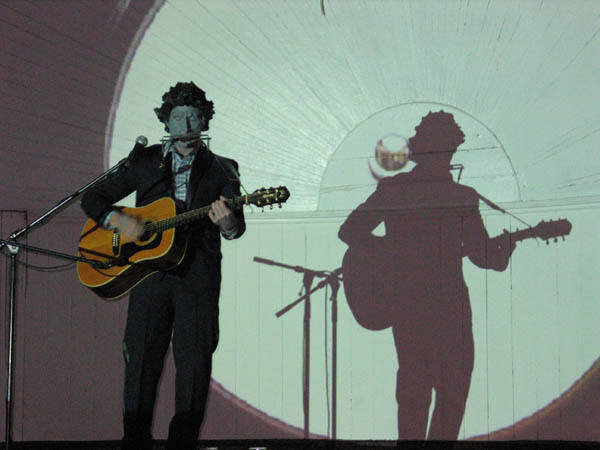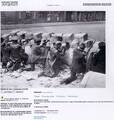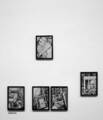Übergordnete Werke und Veranstaltungen
Exhibition Common Property
Media
THE EXHIBITION OF THE 6TH WERKLEITZ BIENNALE
In face of the current tightening of ownership structures, the demand for free access to knowledge and information, especially in the field of cultural production, is becoming pivotal. Together with the artists and producers, the curatorial team of the 6th Werkleitz Biennale has developed various exhibition foci and formats highlighting aspects of the theme of "Common Property": questions relating to the production, storage and communication of knowledge, debates on copyrights and patent laws, conceptions of free distribution of information in public, media and digital spaces, as well as ways of dealing with natural resources and developments in biotechnology.
More than forty individual and collective works of art, group projects, and thematic formats of this year's exhibition are dispersed across different spaces of the Volkspark. Starting with the projects in the entrance area ("Property of the People of Halle") and the lobby (Sharmila Samant, hybrid video tracks), the positions shown inside the Volkspark spread from the two gallery rooms (Eastwood-Real Time Strategy Group, "Networks of Commons", "Insert 2"), the Weineck Saal (Michaela Melián), the central Thälmann Saal with balcony (Can Altay, Edgar Arceneaux, Matthew Buckingham, Ciné-tracts, "Einige RealistInnen", "Insert 3 + 4", Emma Kay, Sebastian Lütgert, Ines Schaber, Sean Snyder, Peter Watkins/Rebond pour la Commune/co-errances, Florian Zeyfang), its anteroom (Dpto. de Intervenciones Públicas, Oda Projesi), the small club room (Christian von Borries, Judith Hopf/Frauke Gust, Anne König/Jan Wenzel, Kristin Lucas) up to the stairwell ("Aktionsraum"). Further projects (Lara Almarcegui, Jeroen Jongeleen, "Insert 1", William Hunt, Eric Sandillon, Tomas Saraceno) are displayed directly in front of the Volkspark and in the urban space.
As a former workers' assembly locale, the Volkspark is not a classical exhibition building, and so it suggested itself to alter the given spatial conditions and bundle the invited contributions by means of architectural interventions. The large partition, a free-standing "white cube", and the enlargement and realignment of the stage areas in the Thälmannsaal now formulate a deliberate over-drawing and reflection of traditional presentation and communication formats.
The artistic works and projects of the exhibition establish a multitude of relations and cross-references to the questions and debates addressed by the biennial. Several exemplary positions are pointed out in the following. The present discussion on the production and communication of knowledge is accompanied by a critical reflection on established recording and ordering systems, as access regulations are ultimately decisive for access to knowledge and information. The contributions of Edgar Arceneaux and Emma Kay, for example, refer to the interest in library systematizations, sociopolitical cartography methods, and the debate on the pretension to power inherent to knowledge sanctioned by the state. Regulatory criteria and principles of categorization and exclusion are closely linked to the question of how history and the generally binding definition and reconstruction of historical data and facts are dealt with. In this regard, the works of Michaela Melián and Florian Zeyfang recontextualize the historical mural (as a form of conveying idealized images of society) and translate the model into a quote-like, copied and associative sample of social clichés. The starting-point of Fred Fröhlich's work are current image politics. Fröhlich animates the digital stock of motifs of commercial image agencies to a sort of overall world view – a speedy sequence of stereotyped representations of the picture motifs we are surrounded by everyday. In the current conflict over intellectual property, the privatisation of knowledge is underpinned by new laws leading to a tightening of copyright provisions in regard to works of art, music, films, books, digital data, and software. Ines Schaber's contribution deals with the business practices of the Corbis company, for instance, that privatises on the Internet historically significant photographs, which are in fact common property, through watermarks. Musical citations and excerpts of Lawrence Lessig's critique of the concept of authorship is the source material Christian von Borries uses for his sound production. While in the field of culture, copyright problems are predominantly discussed with the focus on the figure of the author, within a larger societal frame it is the economies and interests of globally operating corporations that are pressing for the extension of copyright and patent laws. The marketing strategies in the biotech and genetic-engineering sector, for example, are examined and visualised in the contribution of the group hybrid video tracks from Berlin, directing the view to the regional business location Saxony-Anhalt.
Being further examples of a collective practice Oda Projesi (Istanbul) and Depto. de Interventiones Publicás (Havana) have been invited to document their working methods which consist of embedding their specific local contexts.
The increasing privatisation and commercialisation of the public space plays an important role in the discussion on fixing and enforcing property rights. Especially in the last years, the proclamation of a rise in the social need of security and the accompanying measures and campaigns for more control, cleanliness and order in cities have led to the resistance of civil-rights campaigners and activist groups. In this context, artistic contributions were invited to the biennial that initiate the use of free spaces in the surroundings of the Volkspark – like Lara Almarcegui – or that show, in an exemplary manner, how interventions can question existing systems of order and property claims – like Jeroen Jongeleen's sticker and graffiti campaigns.
Next to individual artistic positions, various thematic projects and exhibition sections can be viewed in the Volkspark for which specific formal realisations were chosen. The format "Network of Commons" presents on ten computer terminals producers and groups whose working methods stand for the unimpeded access to and the creative exchange of information on the Internet. Video reports compiled from freely accessible digital archives and displayed on several terminals give insights into the current "Aktionsraum" (Space of Action) of the battles against the privatisation of natural resources and the means of subsistence that are currently taking place around the globe.
The history of the Volkspark and the broader context of the festival at its new venue in Halle form the point of departure for the creation of four "Inserts" adapting historical forms of display and architectural designs from the 1920s and 1950s. The "Inserts 1-4", which are inside the building and on the forecourt of the Volkspark, were worked out by a group of cultural producers, artists and theorists. They thematize discourses of education and representation and tell of the struggles of acquiring property and knowledge, as well as of specific moments in the collective and self-empowering production and utilisation of knowledge.
The exhibition format "Einige RealistInnen" (Some Realists) brings together realistic drawings of various artists. Realism is initially not conceivable without universally valid and seemingly comprehensible image metaphors, yet the pictures only realise themselves in connection with our visual habits. Under the generic term "Realism", the exhibited works show subjective realisations of collective pictorial solutions.
The format "Property of the People of Halle" comprises various objects from public institutions, museums and archives of the city of Halle. The exhibits were made available by these institutions. By this compilation questions are raised as to the social composition, the collective memory, and the self-image of a community and what can be accepted as common history. A.C., A.R.




























